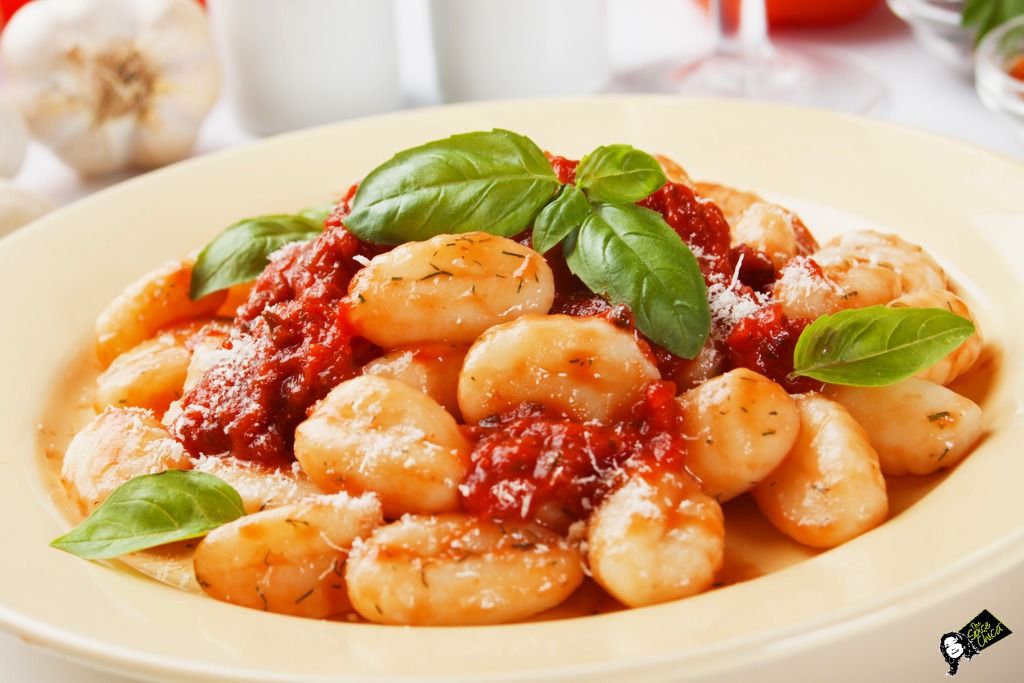For gnocchi with a delicate, melt-in-your-mouth texture, choose the right kind of potatoes and add just enough flour Ingredients (4 ppl) 2 potatoes 2 cups tipo "00" or all-purpose flour 1 egg 1/2 teaspoon of nutmeg water (if needed) Bring a large pot of salted water to a boil. Peel potatoes and add to pot. Cook until tender but still firm, about 15 minutes. Drain, cool and mash with a fork or potato masher. Combine 1 cup mashed potato, flour, nutmeg and egg in a large bowl. Knead until dough forms a ball. Shape small portions of the dough into long "snakes". On a floured surface, cut snakes into half-inch pieces. Bring a large pot of lightly salted water to a boil. Drop in gnocchi and cook for 3 to 5 minutes or until gnocchi have risen to the top; drain and serve.
The keys to delicate gnocchi
Good gnocchi, which are essentially light potato dumplings, shouldn’t be tough or chewy at all; they should be soft and delicate, with a silky-smooth texture—just like my mother’s. It’s easy enough to make gnocchi like this at home: All you need is potatoes, flour, eggs, and a little salt. But you do have to pay attention to a few key points in the process to achieve the right texture.
First, use russet potatoes. They’re dry and fluffy and produce the lightest gnocchi. I also find that it’s best to use a ricer instead of a masher to crush the cooked potatoes, because it keeps them aerated and soft. Never use a blender or a food processor, or the potatoes will turn into glop.
Add just enough flour to hold the dough together, and don’t overmix. The culprit in tough gnocchi is usually one of two things (or both): too much flour in the dough or too much kneading. In the years of making gnocchi with my mother, I’ve learned exactly how much flour I need to add, although I had to adapt the recipe here to American flour and potatoes, both of which are slightly different from what you find in Italy. I’ve also learned that the dough should be kneaded just until the flour is fully incorporated, not a moment longer; otherwise the flour’s gluten will make the gnocchi tough.
When you cut the rope inot small square gnocchi, try to make them as uniform as possible.
Save time: skip the fork Classic Italian homemade gnocchi are pressed on a fork to curl them and impart the traditional ridges. To save time, I just cut them in small squares and leave them as cute little pillows.
MAKE AHEAD AND FREEZE You can serve freshly made gnocchi right away or within a couple of hours, or you can freeze them for later use. Put the gnocchi in the freezer while they’re still on the baking sheets and freeze until they are hard to the touch, at least one hour. Transfer them to a large zip-top bag or several smaller bags and freeze for up to two months. Cook frozen gnocchi in boiling water in two batches. Frozen gnocchi cause the temperature of the cooking water to drop, so they’ll fall apart before the water returns to a boil if there are too many in the pot. Don’t refrigerate fresh gnocchi for more than two or three hours, as they tend to ooze water and become soggy.
Serving gnocchi In Italy, gnocchi are usually served after appetizers (antipasti) as a first course (or primo piatto), instead of pasta. And they’re followed by a meat and vegetable course (secondo piatto and contorno). When Italians eat gnocchi this way, the portions tend to be on the small side. RETRIEVED FROM FINE COOKING WEBSITE> thank you







